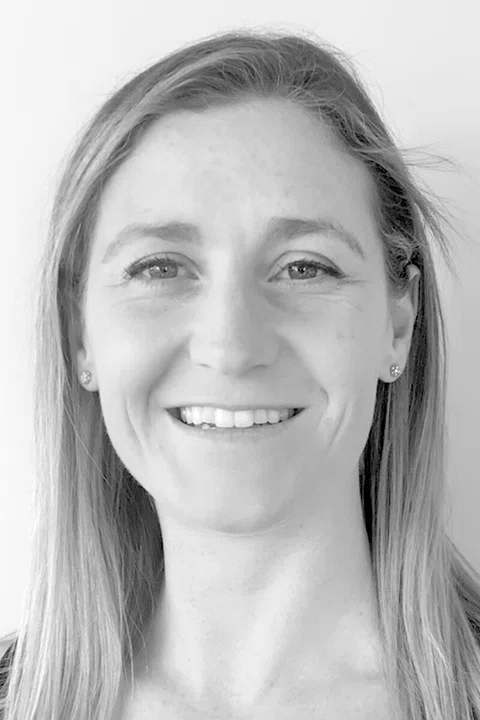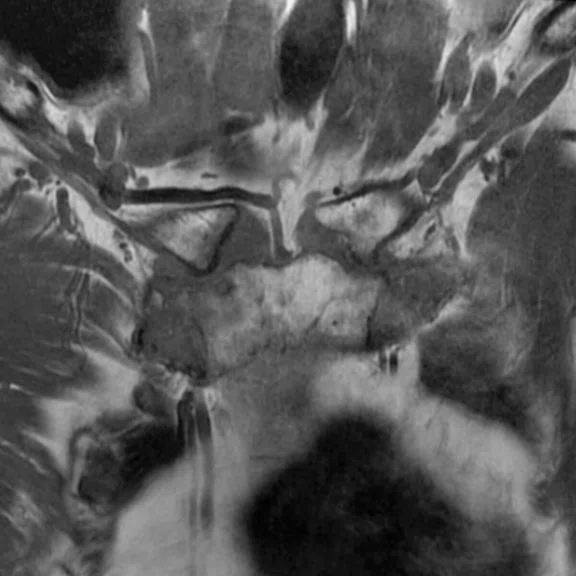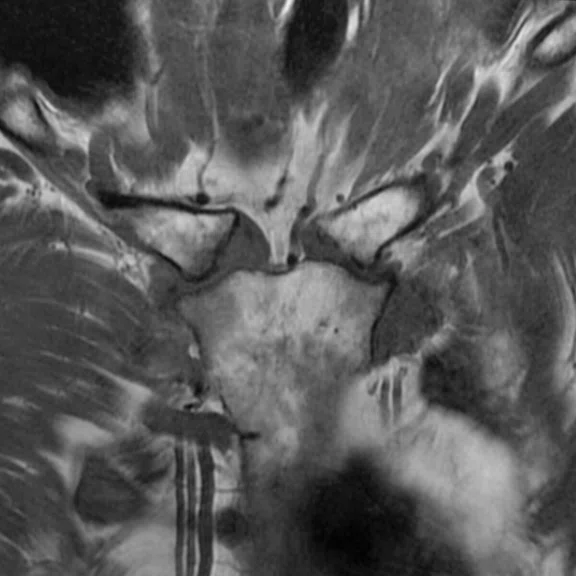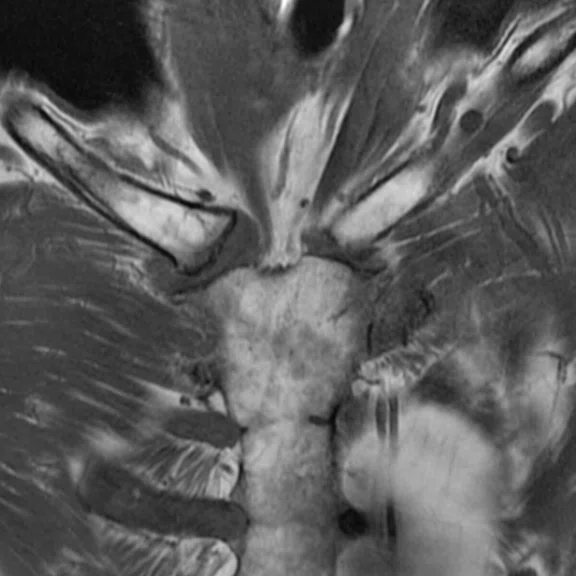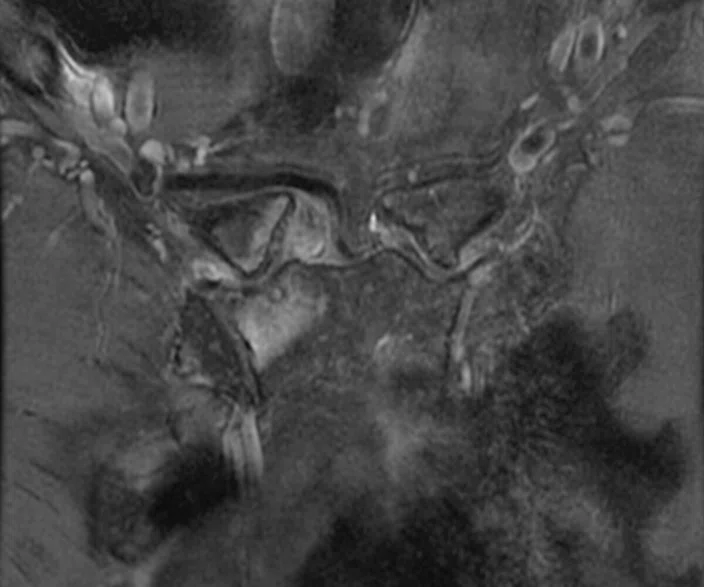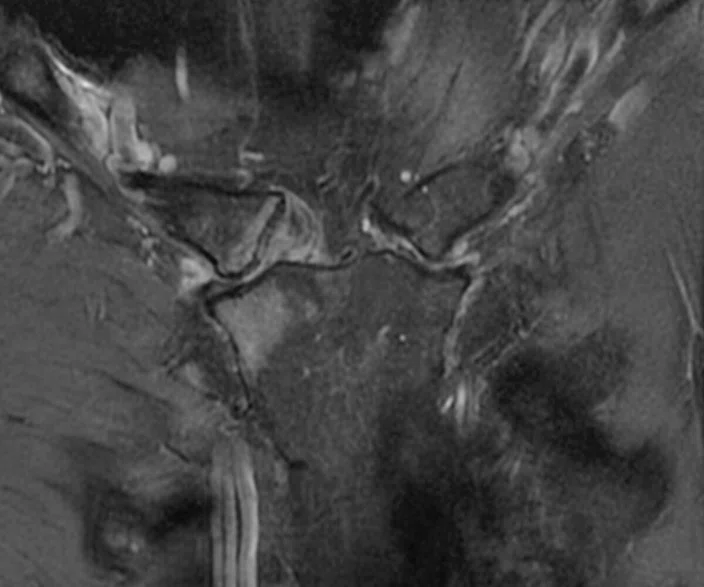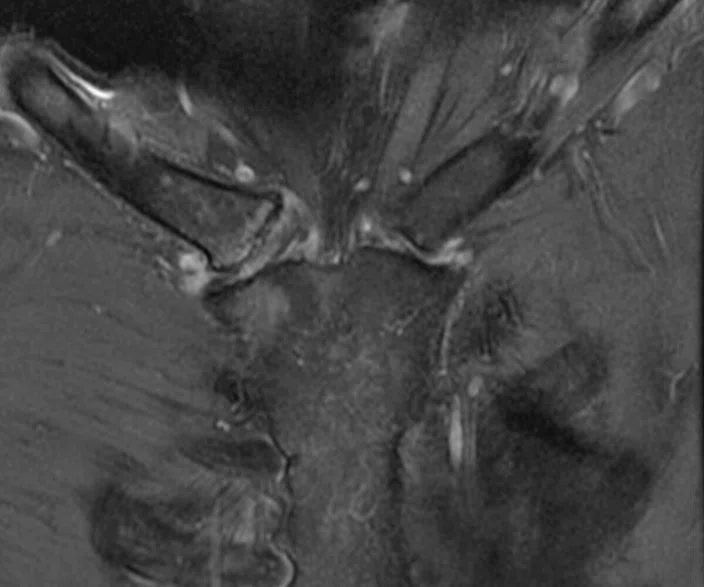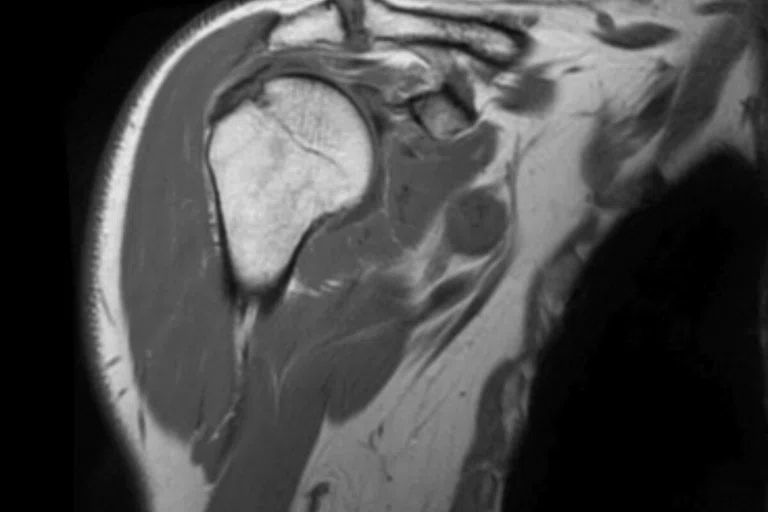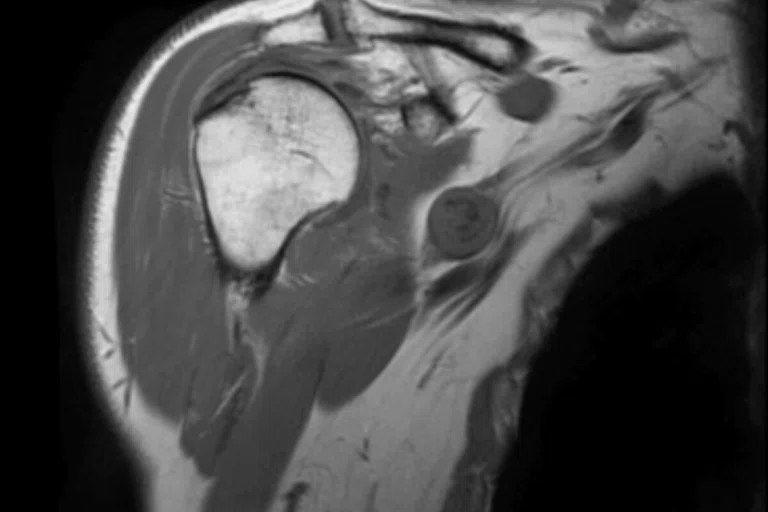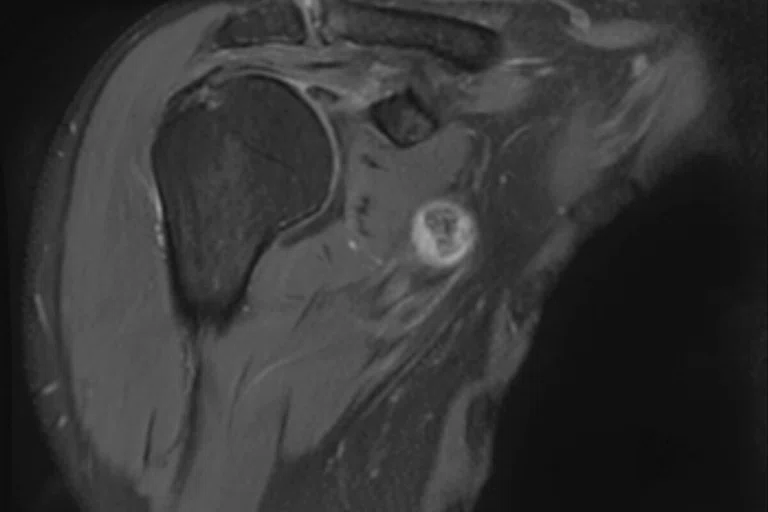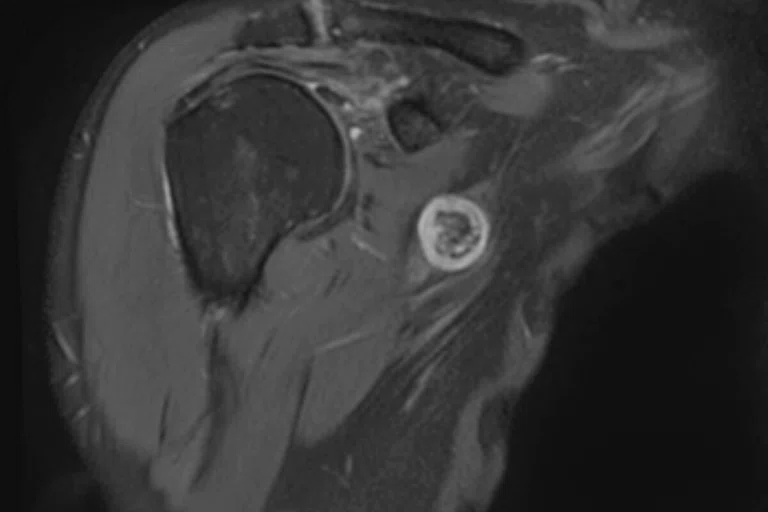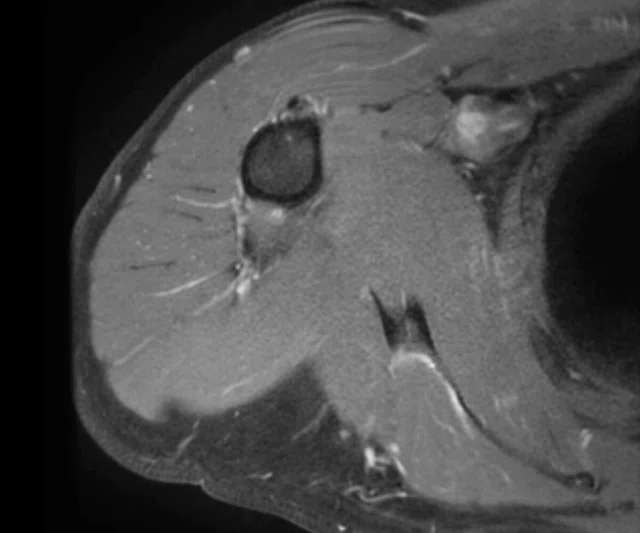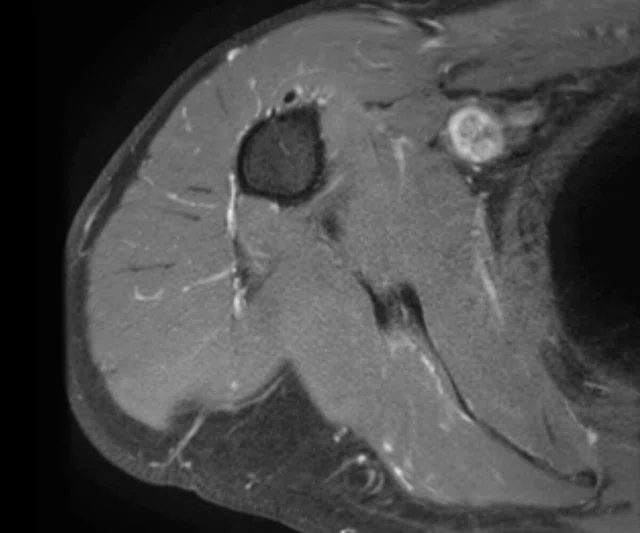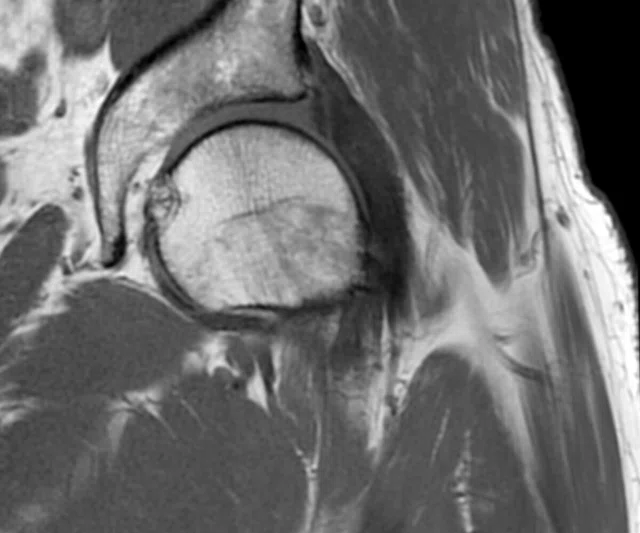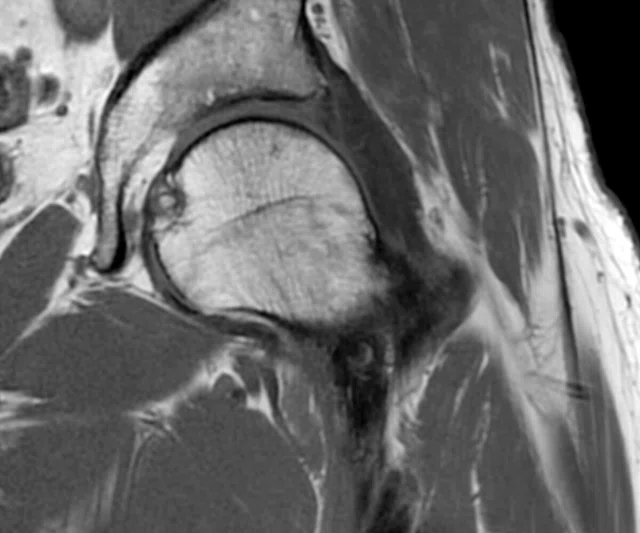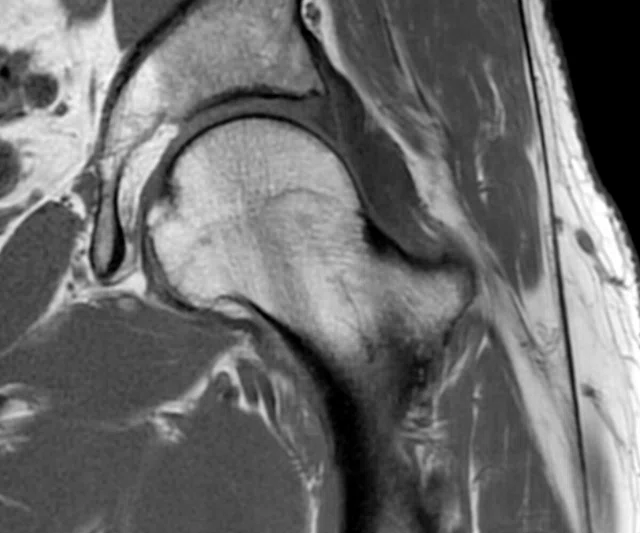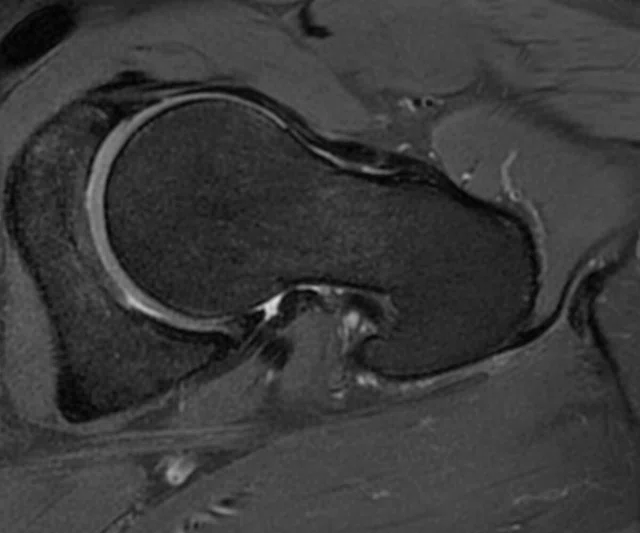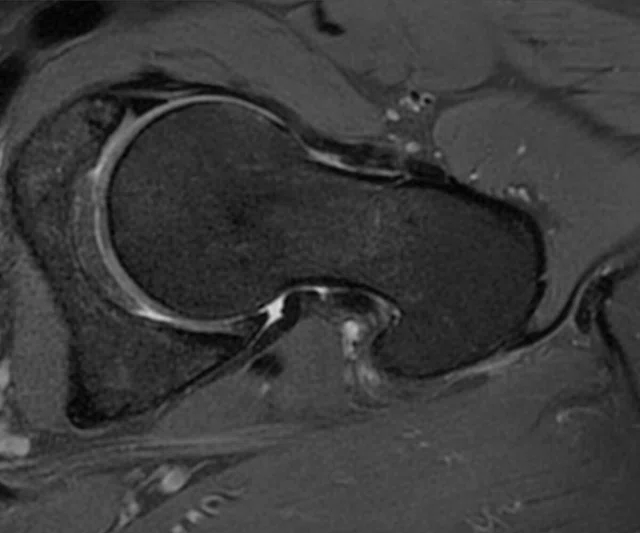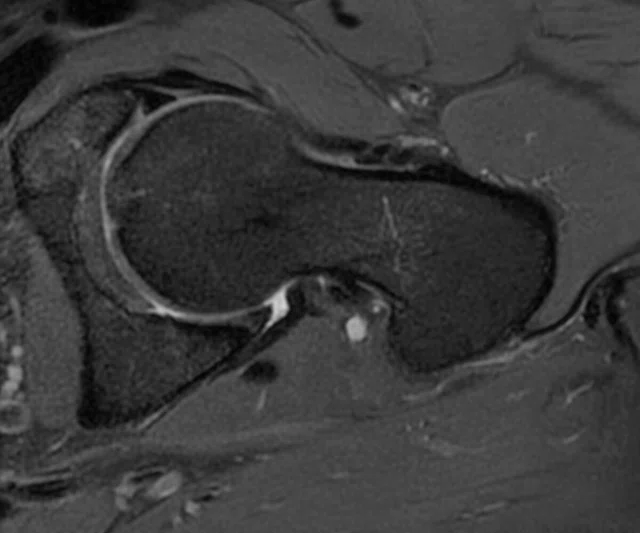A
Figure 4.
Unilateral hip imaging with AIR™ AA Coil. (A-C) T1 coronal and (D-F) PD axial FatSat. Images courtesy of Ascot Radiology
B
Figure 4.
Unilateral hip imaging with AIR™ AA Coil. (A-C) T1 coronal and (D-F) PD axial FatSat. Images courtesy of Ascot Radiology
C
Figure 4.
Unilateral hip imaging with AIR™ AA Coil. (A-C) T1 coronal and (D-F) PD axial FatSat. Images courtesy of Ascot Radiology
D
Figure 4.
Unilateral hip imaging with AIR™ AA Coil. (A-C) T1 coronal and (D-F) PD axial FatSat. Images courtesy of Ascot Radiology
E
Figure 4.
Unilateral hip imaging with AIR™ AA Coil. (A-C) T1 coronal and (D-F) PD axial FatSat. Images courtesy of Ascot Radiology
F
Figure 4.
Unilateral hip imaging with AIR™ AA Coil. (A-C) T1 coronal and (D-F) PD axial FatSat. Images courtesy of Ascot Radiology
A
Figure 1.
Female pelvis imaging with AIR™ AA Coil and PROPELLER MB. (A-C) T2 axial PROPELLER MB; (D-F) T2 sagittal PROPELLER MB; (G-I) T2 coronal SSFSE. Images courtesy of Ascot Radiology
B
Figure 1.
Female pelvis imaging with AIR™ AA Coil and PROPELLER MB. (A-C) T2 axial PROPELLER MB; (D-F) T2 sagittal PROPELLER MB; (G-I) T2 coronal SSFSE. Images courtesy of Ascot Radiology
C
Figure 1.
Female pelvis imaging with AIR™ AA Coil and PROPELLER MB. (A-C) T2 axial PROPELLER MB; (D-F) T2 sagittal PROPELLER MB; (G-I) T2 coronal SSFSE. Images courtesy of Ascot Radiology
D
Figure 1.
Female pelvis imaging with AIR™ AA Coil and PROPELLER MB. (A-C) T2 axial PROPELLER MB; (D-F) T2 sagittal PROPELLER MB; (G-I) T2 coronal SSFSE. Images courtesy of Ascot Radiology
E
Figure 1.
Female pelvis imaging with AIR™ AA Coil and PROPELLER MB. (A-C) T2 axial PROPELLER MB; (D-F) T2 sagittal PROPELLER MB; (G-I) T2 coronal SSFSE. Images courtesy of Ascot Radiology
F
Figure 1.
Female pelvis imaging with AIR™ AA Coil and PROPELLER MB. (A-C) T2 axial PROPELLER MB; (D-F) T2 sagittal PROPELLER MB; (G-I) T2 coronal SSFSE. Images courtesy of Ascot Radiology
G
Figure 1.
Female pelvis imaging with AIR™ AA Coil and PROPELLER MB. (A-C) T2 axial PROPELLER MB; (D-F) T2 sagittal PROPELLER MB; (G-I) T2 coronal SSFSE. Images courtesy of Ascot Radiology
H
Figure 1.
Female pelvis imaging with AIR™ AA Coil and PROPELLER MB. (A-C) T2 axial PROPELLER MB; (D-F) T2 sagittal PROPELLER MB; (G-I) T2 coronal SSFSE. Images courtesy of Ascot Radiology
I
Figure 1.
Female pelvis imaging with AIR™ AA Coil and PROPELLER MB. (A-C) T2 axial PROPELLER MB; (D-F) T2 sagittal PROPELLER MB; (G-I) T2 coronal SSFSE. Images courtesy of Ascot Radiology
A
Figure 3.
Pectoral area imaging with AIR™ AA Coil. (A-B) T1 coronal; (C-D) PD coronal FatSat; and (E-F) PD axial FatSat. Images courtesy of Ascot Radiology
B
Figure 3.
Pectoral area imaging with AIR™ AA Coil. (A-B) T1 coronal; (C-D) PD coronal FatSat; and (E-F) PD axial FatSat. Images courtesy of Ascot Radiology
C
Figure 3.
Pectoral area imaging with AIR™ AA Coil. (A-B) T1 coronal; (C-D) PD coronal FatSat; and (E-F) PD axial FatSat. Images courtesy of Ascot Radiology
D
Figure 3.
Pectoral area imaging with AIR™ AA Coil. (A-B) T1 coronal; (C-D) PD coronal FatSat; and (E-F) PD axial FatSat. Images courtesy of Ascot Radiology
E
Figure 3.
Pectoral area imaging with AIR™ AA Coil. (A-B) T1 coronal; (C-D) PD coronal FatSat; and (E-F) PD axial FatSat. Images courtesy of Ascot Radiology
F
Figure 3.
Pectoral area imaging with AIR™ AA Coil. (A-B) T1 coronal; (C-D) PD coronal FatSat; and (E-F) PD axial FatSat. Images courtesy of Ascot Radiology
A
Figure 1.
Female pelvis imaging with AIR™ AA Coil and PROPELLER MB. (A-C) T2 axial PROPELLER MB; (D-F) T2 sagittal PROPELLER MB; (G-I) T2 coronal SSFSE. Images courtesy of Ascot Radiology
B
Figure 1.
Female pelvis imaging with AIR™ AA Coil and PROPELLER MB. (A-C) T2 axial PROPELLER MB; (D-F) T2 sagittal PROPELLER MB; (G-I) T2 coronal SSFSE. Images courtesy of Ascot Radiology
C
Figure 1.
Female pelvis imaging with AIR™ AA Coil and PROPELLER MB. (A-C) T2 axial PROPELLER MB; (D-F) T2 sagittal PROPELLER MB; (G-I) T2 coronal SSFSE. Images courtesy of Ascot Radiology
G
Figure 1.
Female pelvis imaging with AIR™ AA Coil and PROPELLER MB. (A-C) T2 axial PROPELLER MB; (D-F) T2 sagittal PROPELLER MB; (G-I) T2 coronal SSFSE. Images courtesy of Ascot Radiology
H
Figure 1.
Female pelvis imaging with AIR™ AA Coil and PROPELLER MB. (A-C) T2 axial PROPELLER MB; (D-F) T2 sagittal PROPELLER MB; (G-I) T2 coronal SSFSE. Images courtesy of Ascot Radiology
I
Figure 1.
Female pelvis imaging with AIR™ AA Coil and PROPELLER MB. (A-C) T2 axial PROPELLER MB; (D-F) T2 sagittal PROPELLER MB; (G-I) T2 coronal SSFSE. Images courtesy of Ascot Radiology
D
Figure 1.
Female pelvis imaging with AIR™ AA Coil and PROPELLER MB. (A-C) T2 axial PROPELLER MB; (D-F) T2 sagittal PROPELLER MB; (G-I) T2 coronal SSFSE. Images courtesy of Ascot Radiology
E
Figure 1.
Female pelvis imaging with AIR™ AA Coil and PROPELLER MB. (A-C) T2 axial PROPELLER MB; (D-F) T2 sagittal PROPELLER MB; (G-I) T2 coronal SSFSE. Images courtesy of Ascot Radiology
F
Figure 1.
Female pelvis imaging with AIR™ AA Coil and PROPELLER MB. (A-C) T2 axial PROPELLER MB; (D-F) T2 sagittal PROPELLER MB; (G-I) T2 coronal SSFSE. Images courtesy of Ascot Radiology
A
Figure 3.
Pectoral area imaging with AIR™ AA Coil. (A-B) T1 coronal; (C-D) PD coronal FatSat; and (E-F) PD axial FatSat. Images courtesy of Ascot Radiology
B
Figure 3.
Pectoral area imaging with AIR™ AA Coil. (A-B) T1 coronal; (C-D) PD coronal FatSat; and (E-F) PD axial FatSat. Images courtesy of Ascot Radiology
C
Figure 3.
Pectoral area imaging with AIR™ AA Coil. (A-B) T1 coronal; (C-D) PD coronal FatSat; and (E-F) PD axial FatSat. Images courtesy of Ascot Radiology
D
Figure 3.
Pectoral area imaging with AIR™ AA Coil. (A-B) T1 coronal; (C-D) PD coronal FatSat; and (E-F) PD axial FatSat. Images courtesy of Ascot Radiology
E
Figure 3.
Pectoral area imaging with AIR™ AA Coil. (A-B) T1 coronal; (C-D) PD coronal FatSat; and (E-F) PD axial FatSat. Images courtesy of Ascot Radiology
F
Figure 3.
Pectoral area imaging with AIR™ AA Coil. (A-B) T1 coronal; (C-D) PD coronal FatSat; and (E-F) PD axial FatSat. Images courtesy of Ascot Radiology
A
Figure 2.
Sternoclavicular joint imaging with AIR™ AA Coil. (A-C) T1 coronal and (D-F) T2 coronal FatSat. Images courtesy of Ascot Radiology
B
Figure 2.
Sternoclavicular joint imaging with AIR™ AA Coil. (A-C) T1 coronal and (D-F) T2 coronal FatSat. Images courtesy of Ascot Radiology
C
Figure 2.
Sternoclavicular joint imaging with AIR™ AA Coil. (A-C) T1 coronal and (D-F) T2 coronal FatSat. Images courtesy of Ascot Radiology
D
Figure 2.
Sternoclavicular joint imaging with AIR™ AA Coil. (A-C) T1 coronal and (D-F) T2 coronal FatSat. Images courtesy of Ascot Radiology
E
Figure 2.
Sternoclavicular joint imaging with AIR™ AA Coil. (A-C) T1 coronal and (D-F) T2 coronal FatSat. Images courtesy of Ascot Radiology
F
Figure 2.
Sternoclavicular joint imaging with AIR™ AA Coil. (A-C) T1 coronal and (D-F) T2 coronal FatSat. Images courtesy of Ascot Radiology
result


PREVIOUS
${prev-page}
NEXT
${next-page}
Subscribe Now
Manage Subscription
FOLLOW US
Contact Us • Cookie Preferences • Privacy Policy • California Privacy PolicyDo Not Sell or Share My Personal Information • Terms & Conditions • Security
© 2024 GE HealthCare. GE is a trademark of General Electric Company. Used under trademark license.
SPOTLIGHT
AIR a true asset in the land of Kiwis
AIR a true asset in the land of Kiwis
Be the best that you can be is the motto for AUT Millennium, a charitable trust created to help New Zealanders live longer, healthier lives that is home to several sports clubs and national sporting organizations. The same can be said for Ascot Radiology, the radiology group that provides imaging services at AUT Millennium and seven other sites, including Ascot Hospital and the multi-modality clinic Ascot Central.
Be the best that you can be is the motto for AUT Millennium, a charitable trust created to help New Zealanders live longer, healthier lives that is home to several sports clubs and national sporting organizations. The same can be said for Ascot Radiology, the radiology group that provides imaging services at AUT Millennium and seven other sites, including Ascot Hospital and the multi-modality clinic Ascot Central.
In 2018, Ascot Radiology upgraded its Discovery™ MR750w wide bore system with SIGNA™Works. One year later, the practice completed a SIGNA™ Lift to bring the system up to a SIGNA™ Architect and the latest SIGNA™Works productivity platform featuring some of GE Healthcare’s most advanced MR applications.
“The imaging was good, previously, but naturally we are very happy for any improvement in image quality,” says David Rogers, MBChB, FRANZCR, Managing Director for Ascot Radiology. He noticed the improvement in signal-to-noise ratio (SNR) with the system upgrade and, of course, the new AIR™ Coils.
“The AIR™ Coils are the lightest and most flexible coils available today,” he explains. As a body radiologist specializing in female pelvic imaging, he sees the difference.
Traditional body arrays are heavy, rigid and fixed. “Almost crushing for the patient, and that makes it more difficult for them to regulate their breathing,” Dr. Rogers adds. “The patient would breathe very shallow and then gasp for a deep breath. That, in particular, can ruin the quality of abdominal and pelvic imaging.”
Now, with AIR™ Coils, the patient breathing and related body movement is more regular, and that has led to better image quality with fewer artifacts. Patients are not complaining about the heavy weight on them, which makes for a much better patient experience too.
“We are also seeing superb results in joint imaging with the larger coverage afforded by the AIR™ Coils,” he says. Since the SIGNA™ Architect is in the Ascot Radiology clinic within the AUT Millennium facility, there are many patients who are professional or semi-professional athletes with large forearms and broad shoulders.
The larger coverage also impacts abdominal imaging, such as in the commonly used coronal SSFSE sequence. With the AIR™ Anterior Array (AA) Coil, the coverage is from the diaphragm through the pelvis, whereas with traditional abdominal coils the coverage stopped before the pelvis. That makes a difference in the reading of the exam, as Dr. Rogers can now report from one sequence versus two.
Dr. Rogers has also found that the dynamic range in the images, or the difference between the darkest and lightest tones, is much better in the abdomen and pelvis with the new system and AIR™ Coils. Specifically, the PROPELLER MB motion insensitive sequence now allows more flexible parameter tailoring, and when used in T2 imaging, the endometrium tissue is brighter and the uterus is a darker shade of gray.
“There is much better conspicuity of lesions in these images. I’ve also reviewed several spine exams and found that both the signal and the resolution were improved. Certainly the imaging performance in these areas has increased dramatically. We are more confident diagnostically when we can consistently perform MR exams at a high standard.”
Dr. David Rogers
He recalls a patient who had a spine MR exam on three different occasions: the first on the Discovery™ MR750w, the second on the SIGNA™Works upgrade and a third recently on the SIGNA™ Architect Lift with AIR™ Coils. There is an obvious difference in signal and resolution, he adds, and the different exams of the same patient are a clear demonstration of the increased image quality of the new system and coils.
Patient workflow
Although it is difficult to know whether the improvements are from the upgraded system, new sequences, AIR™ Coils, or a combination of these new technologies, Dr. Rogers notices the shorter scan times with the ARC, HyperSense and HyperCube acceleration techniques and a reduction in motion artifacts with the enhanced PROPELLER MB.
“Having these acceleration techniques available gives us the freedom to choose between the same resolution and a faster scan or better resolution at the same exam time,” Dr. Rogers says. “We are getting better imaging per minute from the scanner.” That ability to save time in a routine exam is important, he adds, because then in difficult cases he can spend the extra time acquiring another view or sequence.
“The AIR™ Coils are really game-changing and make a huge difference in the flexibility of the system.”
Dr. David Rogers
That difference in flexibility is also positively impacting the technologists’ daily workflow and productivity at Ascot Radiology. Lexie Nelson, MRT, (MR radiographer), has found she needs to change fewer coils to get the MR study completed, even when imaging large-sized professional athletes. It also means she is not taking precious scanner time trying to find a coil that fits, which can also delay the next exam(s).
“We have a lot of different-sized patients, from very thin runners to the broad and muscular weight lifters,” Nelson says. “These people would sometimes not fit in a traditional hard shell coil. We would waste time trying two to three different coils and the patient might get embarrassed. Now, we can just wrap the AIR™ Coil around their body part or area, and that gives us a more efficient workflow. Plus, the coil is not so confining or scary-looking, so in some cases it helps us coax the patient into the scanner for their exam.”
With the excellent coil coverage and SNR, Nelson doesn’t have to manipulate the patient’s position as much as before. The flexible, blanket-like design enables her to more easily wrap the coils around the patient and get them in the correct position for imaging. Plus, the larger field of view (FOV) means she can capture the anatomy in one scan versus having to move the coil and scan again.
For example, the technologists will often perform an exam covering the shoulder, clavicle and pectoral area in athletes who are suspected of tearing a muscle in one of these areas.
“I can wrap the AIR™ Coil from the sternum to the arm and get all the information our radiologists need without losing signal or hurting the patient,” Nelson explains. “I don’t have to use two coils. Or, if I’m scanning the shoulder, I can image from the tip of the scapula right down to the midline of the clavicle.” The AIR™ Coil is also used for smaller FOV sternoclavicular joint imaging.
She has the same experience imaging the hips and female pelvis. Nelson will use both the embedded AIR™ Posterior Array (PA) Coil in the table and then wrap the AIR™ AA Coil on top of the patient without moving them.
“It’s good for workflow and the patient, and the images are beautiful. There is no image fallout on the sides, given the large surface area we are scanning,” Nelson adds. The largest coverage and FOV that Nelson has imaged so far is a full femur of a patient who tore their hamstring muscles. She scanned from the crest of the pelvis all the way to the knee — something she could not do with traditional coils and get the necessary coverage.
Several of the newer sequences in SIGNA™Works are also making an impact on the technologist’s workflow and imaging from the SIGNA™ Architect. Nelson can easily change a sequence to PROPELLER MB if a patient is moving, which she says is amazing an improves workflow. When using the FSE Flex sequence in more challenging areas, she doesn’t lose resolution when compared with FSE FatSat acquisitions. Yet, it’s the AIR™ Coils that are life changing.
“I can wrap the AIR™ Coil from the sternum to the arm and get all the information our radiologists need without losing signal or hurting the patient,” Nelson explains. “I don’t have to use two coils. Or, if I’m scanning the shoulder, I can image from the tip of the scapula right down to the midline of the clavicle.” The AIR™ Coil is also used for smaller FOV sternoclavicular joint imaging.
She has the same experience imaging the hips and female pelvis. Nelson will use both the embedded AIR™ Posterior Array (PA) Coil in the table and then wrap the AIR™ AA Coil on top of the patient without moving them.
“It’s good for workflow and the patient, and the images are beautiful. There is no image fallout on the sides, given the large surface area we are scanning,” Nelson adds. The largest coverage and FOV that Nelson has imaged so far is a full femur of a patient who tore their hamstring muscles. She scanned from the crest of the pelvis all the way to the knee — something she could not do with traditional coils and get the necessary coverage.
Several of the newer sequences in SIGNA™Works are also making an impact on the technologist’s workflow and imaging from the SIGNA™ Architect. Nelson can easily change a sequence to PROPELLER MB if a patient is moving, which she says is amazing an improves workflow. When using the FSE Flex sequence in more challenging areas, she doesn’t lose resolution when compared with FSE FatSat acquisitions. Yet, it’s the AIR™ Coils that are life changing.
“The AIR™ Coils are a true asset. I would tell others to get one if they can, and better yet, get two, because they are fabulous.”
Lexie Nelson

A
B
C
D
E
F
G
H
I
Figure 1.
Female pelvis imaging with AIR™ AA Coil and PROPELLER MB. (A-C) T2 axial PROPELLER MB; (D-F) T2 sagittal PROPELLER MB; (G-I) T2 coronal SSFSE. Images courtesy of Ascot Radiology









